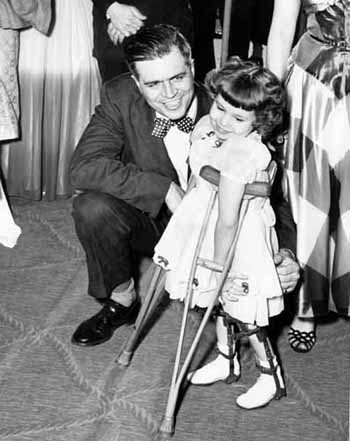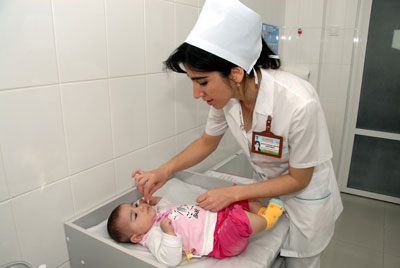The Health Significance Of The Treatment And Prevention Of Poliomyelitis
Michigan Governor G. Mennen Williams with Detroit polio girl Margaret Rose Oxley

Treatment Of Polio
Complete bed rest, analgesics and local heat to sore muscles give symptomatic relief. Since there is no specific treatment, supportive measures are all important. The tendency to wear out muscles which are in a state of partial paresis should be avoided. The respiratory rate, deglutition and blood pressure should be closely monitored to detect complications early. In cases with bulbar polio, feeding by nasogastric tube and parenteral administration of nutrients and fluids may be required. Cases showing signs of respiratory embarrassment, should be nursed in a respiratory intensive care unit.
When the vital capacity drogs to 25 to 30% of normal, endotracheal intubation and artificial respiration are called for normal vital capacity (VC) for adults = 25 X height in cm; VC for children is 20 X age in years. If ventilator failure tends to persist, tracheostomy is indicated.
Once the acute phase is over, the muscle strength return to varying degrees. This improvement is brought about by the recovery of partially damaged neurons, compensatory hypertrophy of the peripheral nerve endings. In most cases, considerable improvement in function is evident in 3 to 4 months. Further improvement is facilitated by active physiotherapy which is intended to prevent wasting and contractures; stimulate and restore to function partially paralysed muscles and to prevent deformities.
Deformities of the axial skeleton develop in severely paralysed patients. The affected limb fails to grow whereas the normal one undergoes compensatory hypertrophy. Contractures may result in further loss of function of the limbs. Planned orthopedic surgery and rehabilitation help to relieve functional and cosmetic disability in such cases.
The Polio Vaccine

Infectious Diseases
Prevention Of Polio
By and large, poliomyelitis is a preventable disease. Prophylactic vaccination has significantly reduced the occurrence of polio epidemics. Two types of vaccines are available- live vaccine (sabin) which is given orally and the killed vaccine (Salk) which is given parenterally. The live vaccine is more widely used. The vaccines containe all the three viruses. The trivalent vaccine is given in three doses in the second, fourth and sixth months of age. The immediate response is the formation of IgM antibodies, to be followed later by the appearance of IgG antibodies in 90 to 99% of cases. In addition, the live attenuated vaccine also stimulates the formation of local IgA which gives immunity in the gut also. Booster doses are given at the age of 1.5 and 5 years.
The vaccines are generally safe. Oral vaccine has produced limited outbreaks of minor paralytic disease, but with the present vaccines this risk is very low. While immunizing children in closed community like a slum or a hostel, it is advisable to cover all the eligible children (up to the age of 10 years if they have not been previously vaccinated). The killed vaccine may produce trivial adverse effects like pain at the site of injection and fever.
Eradication of poliomyelitis can be achieved by full coverage of the population by vaccination, provision of protected water supply and general improvement in hygiene.
© 2014 Funom Theophilus Makama









